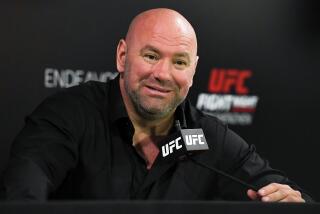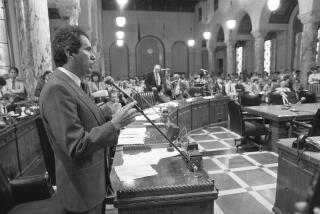Blind Trainer Builds Boxers
The gym--tattered, cramped and smelling of sweat--is filled with young boxers. Some are jumping rope. Others are pounding on punching bags. Two others are in the ring, trading jabs.
Amid it all stands Canto Robledo, owner, manager and trainer of Crown City Stables, who is shouting out instructions to the fighters in the ring. Robledo is intense. This is his gym. These are his fighters. This is his life.
âMy dream is to get a champion of the world,â said Robledo, 72. âIf I had a world champion, I would have quit already.â
It has been the same dream for almost 50 years, ever since a series of boxing injuries blinded Robledo, a one-time bantamweight champion of the Pacific Coast. Ironically, Robledo said, the sport that cost him his sight is the very thing that keeps him motivated today.
âI got into boxing and I love it very much,â Robledo said. âThe gymâs kept me going.â
At last count, Robledo said, he had trained about 500 fighters, including 200 professional boxers--all in backyard gyms that Robledo has had built as he moved from home to home in Pasadena over the years.
Today, the gym sits behind the Robledo home near Fair Oaks Avenue and Orange Grove Boulevard. About 20 young boxers are in training. They range in age from 12 to 25--youths off the street who aspire to either boxing fame or better self-defense. Three have had professional fights. Others have had amateur bouts. All mix easily with older men who visit the gym to keep themselves in shape.
âThereâs a bond,â said Robledoâs son Joe, who helps with the training. âMy father may not see with his eyes but he has inner vision. He has insight. My dad can, and does, teach boxing.
âI think these guys (Robledoâs professional boxers) have a shot. I want to get a world title for him. I would like to put the gold belt around his waist.â
The elder Robledo said the closest he has come to a world champion was in the 1940s, when he trained his two brothers, Joe and Seferino. Joe fought for the bantamweight world championship in 1943, but lost. Seferino was the bantamweight champion of California in 1945, but never fought for the world title.
Robledo said he treats all his fighters like family. He clowns and jokes and scolds and tells them not to give up on their dreams. And if he thinks a boxer is good, he heaps encouragement.
âWeâre good friends,â said Joey Olivera, a seven-year Robledo protege who is fighting professionally in the lightweight division. âHe taught me everything. He got me out of the north side (Pasadena) gangs. He even calls me at night to make sure Iâm not out on the streets.â
Olivera, 21, is known professionally as âThe Pasadena Kid.â He has won 13 of his 17 bouts. Robledo said he trained Olivera the same way he teaches all his fighters--he starts with the art of self-defense, jabbing and balance.
While a fighter is shadowboxing, Robledo will grab the youthâs shoulder, and judging from the fighterâs movements, will correct his routine. Robledo said he teaches by intuition, from experience and by the balance of the fighter.
Scrappy in Childhood
A boxer with proper balance, Robledo said, will have more powerful and speedier punches. Robledo applies this same method when he has fighters throw punches at his padded hands in the ring.
Robledo said he loves working with kids from the street because it takes him back to his own youth. He said that growing up near Santa Fe, N. M., he was continually in one scrape or another. When his family moved to Pasadena in 1922, Robledo said, he just naturally found his way to a neighborhood gym and started to box.
At 16, he said, he was so good at boxing that he turned professional, even though it meant telling boxing officials he was 18 and legally old enough to fight. Robledo was nicknamed âTNTâ in reference to the explosiveness of his punches. His style not only earned him a dynamite nickname, but also made him a dynamite attraction. Robledo fought 44 fights in six years, winning 33, losing 8 and battling to a draw 3 times.
âI went in throwing punches--boom, boom, boom. I didnât stop,â Robledo said.
Founder and columnist of Ring Magazine, Nat Fleischer, writing in a 1931 edition, called Robledo âa two-fisted puncher who takes a punch to give one.â Luis Magana, an official of the Olympic Auditorium in Los Angeles, said that he remembers Robledo as a bruiser.
âA Real Crowd Pleaserâ
âIf the going got tough,â Magana said in an interview, âRobledo forgot boxing and he would slug it out. He was a real crowd pleaser.â
Robledo speaks of his fighting years--1929 to 1935--with panache, recounting his first eight-round fight against Foster Manila in the Pasadena Arena; his 1931 bout with Chalky Wright, who later became featherweight world champion, and his match against one-time flyweight world champion Midget Wolgast. Of those three fights, Robledo won the first two and lost the third.
Among Robledoâs most vivid memories are his five-fight match-up with Speedy Dado, another bantamweight champion of the Pacific Coast. The two fought to a draw in their first and second confrontations. Robledo beat Dado the third time around to gain the divisionâs Pacific Coast title. They fought to a draw the fourth time, and Dado won the last fight.
Robledoâs sight did not vanish with one pounding blow. It left him gradually. In 1931, Robledo said, his left eye began to blur, but he ignored the fuzziness, thinking it would go away. It did not. By 1933, he said, a cataract made him completely blind in his left eye.
Robledo said he continued to box, but had to fight out of the state because California boxing regulations would not allow him to enter the ring with his injury. By 1934, he said, his right eye had begun to blur. Robledo said he was scared, and told his manager he did not want to fight, but did anyway because he felt obligated to fulfill his contract.
Retina Injured
Robledo said his last fight, against Hilo Hernandez in Seattle, resulted in a detached retina. Within days, he said, he could hardly see. Within a year, he said, his sight was completely gone. He was 22.
Robledo said he was despondent and drank heavily. He underwent three eye operations, but only one came close to success. For a brief three days in 1935, Robledo said, sight was restored to his right eye and he was able to see again. But he said he lost that sight when he became so nervous during recovery in the hospital that he ripped off his bandages prematurely. The bandages were applying pressure, holding the retina in place, and by removing them it caused the retina and tissues to collapse.
Robledo insists that bitterness has since left him. Yet, at times, an intense melancholy seems to overwhelm him.
âI donât want to think about those days,â he said. âThe sight left me. It kind of hurts to think of it.â
Robledoâs wife of nearly 53 years, Conchita, said that after the operations failed, it was visits from neighborhood children that brought her husband out of his depression. Soon, she said, Robledo was showing kids how to jab and throw punches.
Uses Sense of Touch
Eventually, with the aid of two friends, Robledo built his first gym from âwhatever we could findâ in 1941.
âI thought, âHow am I going to teach these guys?â â Robledo said. âI began to touch and feel. It took me six months, and then I got my sense of touch. And thatâs how I train fighters.â
Conchita Robledo said that over the years her husband has continually worried about injuries to his fighters--especially injuries to the eyes--and has told his fighters that winning a match is not worth risking permanent injury.
âHe would prevent them from getting hurt,â she said. âHeâd pull them out of a fight if they were hurt.â
Robledo said he has no plans to retire--at least until one of his three professional boxers gets a shot at a world championship. He said boxing has always been his life, and that he still gets excited when a young fighter comes off the street and uses boxing to turn his life around.
Besides, Robledo said, âeveryone in the gym is my friend.â
More to Read
Go beyond the scoreboard
Get the latest on L.A.'s teams in the daily Sports Report newsletter.
You may occasionally receive promotional content from the Los Angeles Times.










